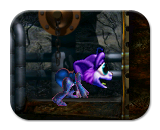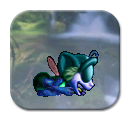Bridging a C2 Problem and Finding Another
 The first order of business with Colony Twelve in Creatures 2 was to ensure that no one else would meet the same untimely end as Ectatomma 3. The last two females from that group decided to test the bridge out immediately, and even brought along an actual ant! Traveling around the entire world was something that all of the Norns could do, but this removed one very dangerous obstacle. My goal was not to create a perfect world devoid of perils, yet this ocean seemed to spell certain death for any Norn who chanced by. These two females decided to stay close together.
The first order of business with Colony Twelve in Creatures 2 was to ensure that no one else would meet the same untimely end as Ectatomma 3. The last two females from that group decided to test the bridge out immediately, and even brought along an actual ant! Traveling around the entire world was something that all of the Norns could do, but this removed one very dangerous obstacle. My goal was not to create a perfect world devoid of perils, yet this ocean seemed to spell certain death for any Norn who chanced by. These two females decided to stay close together.
 There were many eggs throughout the world, but I was dismayed to discover that none were hatching. I chanced upon a male who demonstrated just what was going on: These Norns showed great interest in the eggs, and treated them like toys. Luckily, I was able to use a COB to unpause all eggs and avoid the need for the incubator. Both the Allomerus and Tetramorium groups looked to be in healthy shape. The lone Ectatomma females were on their own, while the Myrmica group had become completely spread out. Before long, I was ready to take a look at the new inhabitants of the world. None of the males showed signs of aging, although I only expected them to live for about 20-40 minutes.
There were many eggs throughout the world, but I was dismayed to discover that none were hatching. I chanced upon a male who demonstrated just what was going on: These Norns showed great interest in the eggs, and treated them like toys. Luckily, I was able to use a COB to unpause all eggs and avoid the need for the incubator. Both the Allomerus and Tetramorium groups looked to be in healthy shape. The lone Ectatomma females were on their own, while the Myrmica group had become completely spread out. Before long, I was ready to take a look at the new inhabitants of the world. None of the males showed signs of aging, although I only expected them to live for about 20-40 minutes.
 An egg finally burst open to reveal the first second generation Albian Ant Norn. She was of the Allomerus group, although she hatched in a very odd location. Apparently her parents decided to take a ride in a lift and proclaim their love in the very sparse music room near the pond and Shee statue. This little female actually survived a long time without eating anything. I expected her to perish early on, yet she was smart enough to use the lift when she was older. Rather resourceful, just like a real ant.
An egg finally burst open to reveal the first second generation Albian Ant Norn. She was of the Allomerus group, although she hatched in a very odd location. Apparently her parents decided to take a ride in a lift and proclaim their love in the very sparse music room near the pond and Shee statue. This little female actually survived a long time without eating anything. I expected her to perish early on, yet she was smart enough to use the lift when she was older. Rather resourceful, just like a real ant.
 Another birth soon occurred, and it was soon evident that these Norns were reproducing rather quickly. This little male enjoyed a wonderful view of the waterfall. I assumed that his coloring was unique, until I remembered that Albian Ant Norns have different pigments at each life stage. This was another member of the Allomerus group, although his father was from the Myrmica group. In the next round of births, it became quite evident that these two groups were forever mixed together. I named them based on the group of the female line, since this was a social structure centered around the queens.
Another birth soon occurred, and it was soon evident that these Norns were reproducing rather quickly. This little male enjoyed a wonderful view of the waterfall. I assumed that his coloring was unique, until I remembered that Albian Ant Norns have different pigments at each life stage. This was another member of the Allomerus group, although his father was from the Myrmica group. In the next round of births, it became quite evident that these two groups were forever mixed together. I named them based on the group of the female line, since this was a social structure centered around the queens.
 The first natural death was expected, as many of the breeding males were nearing the end of their lives. I was quite dismayed to discover that this apparently natural death was of the baby male just mentioned: Allomerus 6 died in an early life stage, not from hunger nor disease. Indications pointed to a genetic mutation. In actuality, this colony had many types of mutations. One Norn was in constant pain, while another suffered from extreme cold. I only wished that the mutations could affect something benign like the pigments.
The first natural death was expected, as many of the breeding males were nearing the end of their lives. I was quite dismayed to discover that this apparently natural death was of the baby male just mentioned: Allomerus 6 died in an early life stage, not from hunger nor disease. Indications pointed to a genetic mutation. In actuality, this colony had many types of mutations. One Norn was in constant pain, while another suffered from extreme cold. I only wished that the mutations could affect something benign like the pigments.
 Time flew by with the quick lifespans of these Norns, yet I had to pause to bid farewell to Ectatomma 1 and Ectatomma 2. One even chanced to pass away on the bridge, which would forever be known as the Ectatomma Bridge. One male, Allomerus 8, was actually just one level below them at one point. I was tempted to intervene and ensure the survival of their line, but I managed to let nature take its course. Although these two females never bred and had no offspring, their lives had not been in vain. They saw the surface of the world and managed to see all manner of wonders. Perhaps they would find Ectatomma 3 in the place where all Norns go when they float away.
Time flew by with the quick lifespans of these Norns, yet I had to pause to bid farewell to Ectatomma 1 and Ectatomma 2. One even chanced to pass away on the bridge, which would forever be known as the Ectatomma Bridge. One male, Allomerus 8, was actually just one level below them at one point. I was tempted to intervene and ensure the survival of their line, but I managed to let nature take its course. Although these two females never bred and had no offspring, their lives had not been in vain. They saw the surface of the world and managed to see all manner of wonders. Perhaps they would find Ectatomma 3 in the place where all Norns go when they float away.
 It certainly was true that these Norns were inclined to travel. Several formed a small unit in the volcano, of all places. I had hopes that they might form a new group, as there were two females and one male. Unfortunately, he passed away too soon. The other two females perished, one of which was Myrmica 2. She was the first original breeding queen to pass away. With no male to keep her young, it was understandable why she passed away at a relatively young age. Yet that was another death without a corresponding birth.
It certainly was true that these Norns were inclined to travel. Several formed a small unit in the volcano, of all places. I had hopes that they might form a new group, as there were two females and one male. Unfortunately, he passed away too soon. The other two females perished, one of which was Myrmica 2. She was the first original breeding queen to pass away. With no male to keep her young, it was understandable why she passed away at a relatively young age. Yet that was another death without a corresponding birth.
 In actuality, the population was in serious trouble. The Tetramorium group had grown the largest, yet all of the males soon died out. Six females ruled over the group, but had no purpose. I had to make a choice to start another group, or hatch a new male to help keep the Tetramorium group alive. The Allomerus-Myrmica mixed group was also in danger of dying out with just one male near enough to breed with the remaining queen. To intervene, or not to intervene? I was utterly torn by the decision.
In actuality, the population was in serious trouble. The Tetramorium group had grown the largest, yet all of the males soon died out. Six females ruled over the group, but had no purpose. I had to make a choice to start another group, or hatch a new male to help keep the Tetramorium group alive. The Allomerus-Myrmica mixed group was also in danger of dying out with just one male near enough to breed with the remaining queen. To intervene, or not to intervene? I was utterly torn by the decision.







